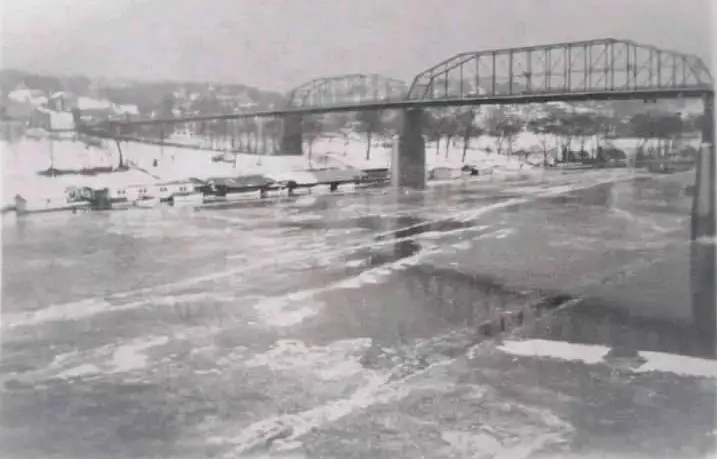
The Freezing of the Tennessee River in Chattanooga, January 1940: A Remarkable Event in Southern History…
In January 1940, a rare and remarkable event occurred in Chattanooga, Tennessee, a city known for its mild winters and beautiful river landscapes: the Tennessee River froze over. This was an unusual occurrence in a region where winter temperatures rarely dip far enough below freezing to cause such a dramatic freeze. The freezing of the Tennessee River in Chattanooga not only captured the imagination of local residents but also garnered significant media attention, becoming a part of the city’s historical lore.
This article explores the historical context of the event, the factors that contributed to the freezing of the river, the impact on the local community, and how the event is remembered today.
The Tennessee River and Chattanooga’s Climate
The Tennessee River is one of the longest rivers in the United States, flowing 652 miles through the southeastern United States. The river runs through the states of Tennessee, Alabama, Mississippi, and Kentucky, and plays a crucial role in transportation, commerce, and agriculture in the region. For Chattanooga, the river has always been central to its identity, serving as both a natural resource and a vital transportation route for steamboats and barges.
Chattanooga’s climate is characterized as humid subtropical, meaning that winters in the area tend to be mild, with average January temperatures around 40 to 45 degrees Fahrenheit (4 to 7 degrees Celsius). Snowfall is rare, and ice formation on rivers and lakes is even rarer. However, there are occasional cold snaps, and in the winter of 1940, the region experienced one of the most intense and prolonged cold periods in decades.
The Winter of 1939-1940: A Harbinger of Cold
The winter of 1939-1940 was an unusually harsh one across much of the United States, especially in the southern and central parts. The country was experiencing the tail end of the Great Depression, and the economy was still reeling from the effects of the stock market crash of 1929. Cold waves and severe weather patterns swept across much of the nation during this period, creating harsh conditions for many communities.
In Chattanooga, temperatures plummeted, and a combination of snow, freezing rain, and sub-zero temperatures set the stage for the freezing of the Tennessee River. In early January, a prolonged cold snap settled over the region, and temperatures in Chattanooga dropped well below freezing, with some days failing to rise above 20 degrees Fahrenheit (-6 degrees Celsius). The region had already experienced several days of freezing temperatures, and the conditions were ripe for a dramatic natural event.
The River Freezes
On January 20, 1940, the Tennessee River at Chattanooga froze. The freezing of the river was not a simple occurrence of ice forming on the surface of the water; it was a significant event in that the ice covered a substantial portion of the river, thick enough to create a frozen surface that could be seen and traversed in some locations.
The freezing of such a large and important waterway was an extraordinary sight. While rivers in colder northern regions of the U.S. regularly freeze over in winter, it was nearly unheard of for the Tennessee River to do so, especially in the southern part of its path where the mild temperatures generally prevent such extreme cold from lasting long enough to create thick ice.
Local residents and tourists alike were stunned by the sight of a frozen river. News outlets from across the country picked up the story, and photographs of the Tennessee River covered in ice appeared in newspapers, making it a widely recognized event. For many, it was a once-in-a-lifetime occurrence, and the frozen river became a subject of wonder and curiosity.
The Impact on Chattanooga and the Surrounding Area
The freezing of the Tennessee River had both symbolic and practical effects on the city of Chattanooga. On the one hand, it was a testament to the power of nature and a reminder of how rare and unpredictable weather events can be. On the other hand, the freeze had some immediate impacts on the local economy and daily life.
1. Transportation Disruptions: The river had long been a crucial part of the region’s transportation infrastructure. Barges and steamboats typically navigated the Tennessee River, transporting goods like coal, steel, and agricultural products. The freeze brought that activity to a standstill. Shipping along the river was halted, causing a temporary disruption in trade and supply chains. However, the impact was less severe than it would have been had the freeze occurred at a more economically critical time.
2. Local Economy: While the freeze caused some logistical challenges, the economic impact of the frozen river was relatively short-lived. The more significant challenge was the prolonged cold weather, which affected daily life in the city. Cold temperatures caused issues with heating and water supply for many homes, and the cost of heating materials like coal and firewood rose. For a brief period, people had to adjust to the discomfort and inconvenience of an unusually harsh winter.
3. Public Interest: The freezing of the river became a major talking point for locals. Families took advantage of the rare event by walking on the ice, taking photographs, and simply enjoying the spectacle. For children, the frozen river was an opportunity to skate and play on the ice, though this came with the inherent dangers of thin ice in some places.
4. Environmental Consequences: The extended cold weather and the frozen river had some environmental consequences. The freeze affected the local wildlife and could have caused damage to the fish population. The icy conditions also created challenges for local flora, especially in areas near the river where ice accumulation and freezing temperatures could have harmed plant life.
A Lasting Memory
Despite its short duration, the freezing of the Tennessee River in January 1940 has remained a part of Chattanooga’s folklore. The event was so rare that many older residents still recount it as a vivid memory of their childhood. Local historians and weather enthusiasts often cite the freeze as one of the most dramatic weather events in the city’s history.
In modern times, the event serves as a reminder of how even the mildest of regions can experience extreme weather conditions, and how such occurrences can leave lasting impressions on a community. The freezing of the Tennessee River has also become a symbol of nature’s power and unpredictability, demonstrating that even in the heart of the South, nature can surprise us.
Conclusion
The freezing of the Tennessee River in Chattanooga in January 1940 was an extraordinary event that captured the attention of the local community and the broader public. While the freeze caused temporary disruptions to transportation and daily life, it also became a symbol of the power of nature and the unpredictability of weather patterns. The event is still remembered today as a significant moment in Chattanooga’s history, a rare reminder of a time when the Tennessee River normally a symbol of flow and movement became a still, frozen expanse. For those who witnessed it, the frozen river remains an unforgettable image, a rare historical moment frozen in time.






